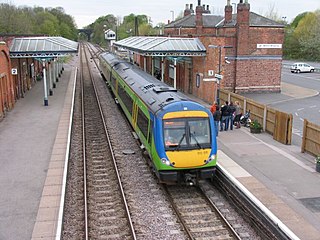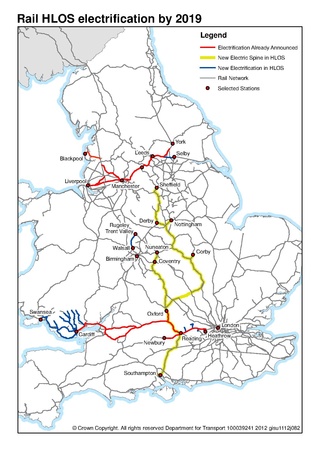
The West Coast Main Line (WCML) is one of the most important railway corridors in the United Kingdom, connecting the major cities of London and Glasgow with branches to Birmingham, Manchester, Liverpool and Edinburgh. It is one of the busiest mixed-traffic railway routes in Europe, carrying a mixture of intercity rail, regional rail, commuter rail and rail freight traffic. The core route of the WCML runs from London to Glasgow for 399 miles (642 km) and was opened from 1837 to 1881. With additional lines deviating to Northampton, Birmingham, Manchester, Liverpool and Edinburgh, this totals a route mileage of 700 miles (1,127 km). The Glasgow–Edinburgh via Carstairs line connects the WCML to Edinburgh. However, the main London–Edinburgh route is the East Coast Main Line. Several sections of the WCML form part of the suburban railway systems in London, Coventry, Birmingham, Manchester, Liverpool and Glasgow, with many more smaller commuter stations, as well as providing links to more rural towns.

The Port of Felixstowe, in Felixstowe, Suffolk, is the United Kingdom's largest container port, dealing with 48% of Britain's containerised trade. In 2017, it was ranked as 43rd busiest container port in the world and 8th in Europe, with a handled traffic of 3.85 million twenty-foot equivalent units (TEU). In 2019 it was ranked the UKs 7th busiest port.

The Birmingham–Peterborough line is a cross-country railway line in the England, linking Birmingham, Leicester and Peterborough, via Nuneaton, Oakham and Stamford

Nuneaton railway station serves the market town of Nuneaton in Warwickshire, England. The station is managed by West Midlands Trains. It is served by three railway lines: the Trent Valley section of the West Coast Main Line (WCML), the Birmingham-Leicester-Peterborough line and the Coventry to Nuneaton branch line. The station was known, during the period 1924–1969, as Nuneaton Trent Valley, to distinguish it from the now closed Nuneaton Abbey Street station; many local people still refer to it as Trent Valley.

Denton railway station serves the town of Denton in Tameside, Greater Manchester, England, on the Stockport–Stalybridge line. It is served by two trains a week, one in each direction on Saturday mornings.

The Ely–Peterborough line is a railway line in England, linking East Anglia to the Midlands. It is a part of the Network Rail Strategic Route 5, SRS 05.07 and is classified as a secondary line. It is used by a variety of inter-regional and local passenger services from East Anglia to the West Midlands and North West, as well as freight and infrastructure traffic; it also links with the busy East Coast Main Line at its western end. Fenland District council put forward their Rail Development Strategy for the route in 2012, which includes infrastructure upgrades for the intermediate stations, improved frequencies for the services using it and establishing a Community Rail Partnership for the line in 2013–14.
Network Rail (NR) has an obligation, transferred from the abolished Strategic Rail Authority, to periodically produce Route Utilisation Strategy (RUS) documents. The original programme was approved by the Office of Rail Regulation (ORR) in June 2006; under an early version of the programme all but two RUSs were scheduled to be completed by the end of Control Period 3 (CP3), 31 March 2009. The programme and its timescale were reviewed by NR and ORR at regular intervals. Despite this the delivery timescales continually slipped: at the end of CP3 no fewer than 9 remained incomplete, despite the fact that funding for infrastructure developments in CP4 was largely set.
The South West Main Line Route Utilisation Strategy was the first Route Utilisation Strategy (RUS) to be produced under the new Network Rail regime. As such it did not completely adhere to the format that has subsequently become 'standard', and needs to be read in conjunction with the prior Draft for Consultation. It was published in May 2006 and was included in a map published by the Office of Rail Regulation as established in May 2007.
The Scotland Route Utilisation Strategy is a Route Utilisation Strategy, published by Network Rail in March 2007, the third RUS to be published. The railways in Scotland are divided into three strategic routes, namely Route 24, Route 25 (Highlands) and Route 26 together with parts of Route 8 and Route 18. The three strategic routes form the scope of Network Rail's Scotland Route Utilisation Strategy. Separate RUSs for the ECML and WCML encompass the relevant parts of routes 8 and 18. The Edinburgh Crossrail service, which provides a direct route between Stirling, Dunblane and Bathgate in the west to Newcraighall in the east, operates over part of the ECML east of Edinburgh Waverley to Portobello Junction.
The North West Route Utilisation Strategy (NWRUS) is a Route Utilisation Strategy, published by Network Rail in May 2007. It was the fifth RUS to be produced. It was included in a map published by the Office of Rail Regulation as established in May 2007. It was the first of no fewer than 5 RUSs which cover specific routes in the north-west of England; the others are the Lancashire & Cumbria RUS, the Yorkshire & Humber RUS, the Merseyside RUS, and the West Coast Main Line RUS. In particular it "broadly covers the Manchester journey to work area, the City lines into Liverpool Lime Street and routes from Manchester to Kirkby, Southport and Blackpool", corresponding to Network Rail's then Route 20 - North West Urban.
The Greater Anglia Route Utilisation Strategy is a Route Utilisation Strategy published by Network Rail in December 2007. It was the sixth RUS to be produced. The area covered includes the whole of Route 5 West Anglia (WA) and Route 7 Great Eastern (GE), which both focus for passenger purposes on London Liverpool Street, and the London Fenchurch Street services from Route 6. As with other RUSs, the Greater Anglia RUS took into account a number of responses, including the Office of Rail Regulation (ORR).
The East Coast Main Line Route Utilisation Strategy (RUS), published by Network Rail in February 2008, was the seventh RUS.
Network Rail's (NR) South London Route Utilisation Strategy (SLRUS), published in March 2008 (SLRUS) was the eighth Route Utilisation Strategy to be produced. By default, RUSs are established by the Office of Rail Regulation (ORR) unless the latter objects within 60 days. The RUS is included in NR's map as established.
The Lancashire and Cumbria Route Utilisation Strategy is a Route Utilisation Strategy, published by Network Rail on 29 August 2008 It was the ninth RUS to be produced.
The Yorkshire and Humber Route Utilisation Strategy is a Route Utilisation Strategy (RUS), published by Network Rail in July 2009; it was the twelfth RUS to be completed, not counting the partially completed Network RUS.
The Kent Route Utilisation Strategy (KRUS) is a Route Utilisation Strategy (RUS), published by Network Rail (NR) in January 2010. it was the thirteenth RUS to be completed, not counting the partially completed Network RUS. By default, RUSs are established by the Office of Rail Regulation (ORR) unless the latter objects within 60 days; and the ORR have confirmed no objection to the establishment of the Kent RUS.
The Sussex Route Utilisation Strategy is a Route Utilisation Strategy (RUS), published by Network Rail (NR) in January 2010. It was the fourteenth RUS to be completed, not counting the partially completed Network RUS. By default, RUSs are established by the Office of Rail Regulation (ORR) unless the latter objects within 60 days, and the ORR have confirmed no objection to the establishment of the Sussex RUS.

The "Electric Spine" was the name for part of a, now largely cancelled, rolling programme of railway electrification projects in England initially estimated to cost £800 million, but later thought to cost close to £3 billion. The aim was to form 25 kV AC overhead-wire electrified links northward from the Port of Southampton to major cities in northern and central England and dry port container terminals in the Midlands. The government wanted efficient electric-hauled freight trains to compete with road haulage.

The South Humberside Main Line runs from Doncaster on the East Coast Main Line to Thorne where it diverges from the Sheffield to Hull Line. It then runs eastwards to Scunthorpe and the Humber ports of Immingham and Grimsby, with the coastal resort of Cleethorpes as terminus.
The Felixstowe to Nuneaton railway upgrade in the United Kingdom is a series of upgrades being made to both a key strategic freight route and one that carries passengers on many parts. It is one of only two routes between the busiest container port and the Midlands, the other being via London. The route and the upgrade is sometimes abbreviated to F2N. The railway route includes the Birmingham–Peterborough line for a large part. The line links the Port of Felixstowe in Felixstowe, Suffolk, with the Midlands and crosses the East Coast Main Line, the Midland Main Line and the West Coast Main Line and thus the north and Scotland. From Nuneaton, a number of intermodal terminals may be reached. Much infrastructure in the UK is of Victorian origin and thus needed an upgrade; F2N, being a key route, is no exception.







